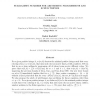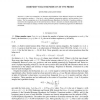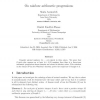18 search results - page 1 / 4 » Sub-Ramsey Numbers for Arithmetic Progressions |
ENDM
2007
13 years 4 months ago
2007
For a given positive integer k, sr(m, k) denotes the minimal positive integer such that every coloring of [n], n ≥ sr(m, k), that uses each color at most k times, yields a rainb...
GC
2006
Springer
13 years 4 months ago
2006
Springer
EM
2010
12 years 11 months ago
2010
Under two assumptions, we determine the distribution of the difference between two functions each counting the numbers x that are in a given arithmetic progression modulo q and the...
ITA
2006
13 years 4 months ago
2006
Arithmetical complexity of a sequence is the number of words of length n that can be extracted from it according to arithmetic progressions. We study uniformly recurrent words of l...
COMBINATORICS
2004
13 years 4 months ago
2004
Consider natural numbers {1,



